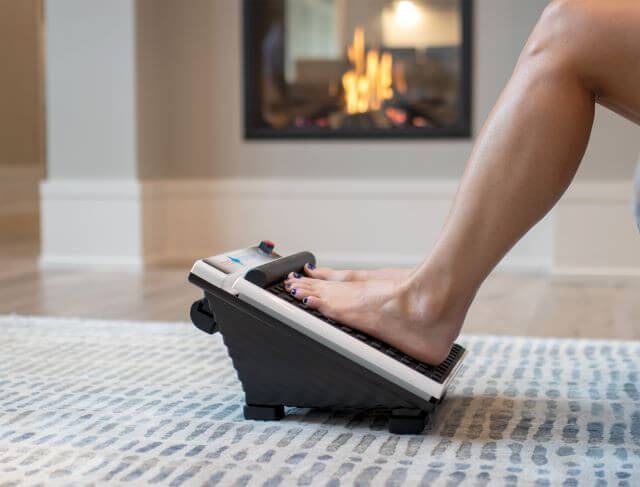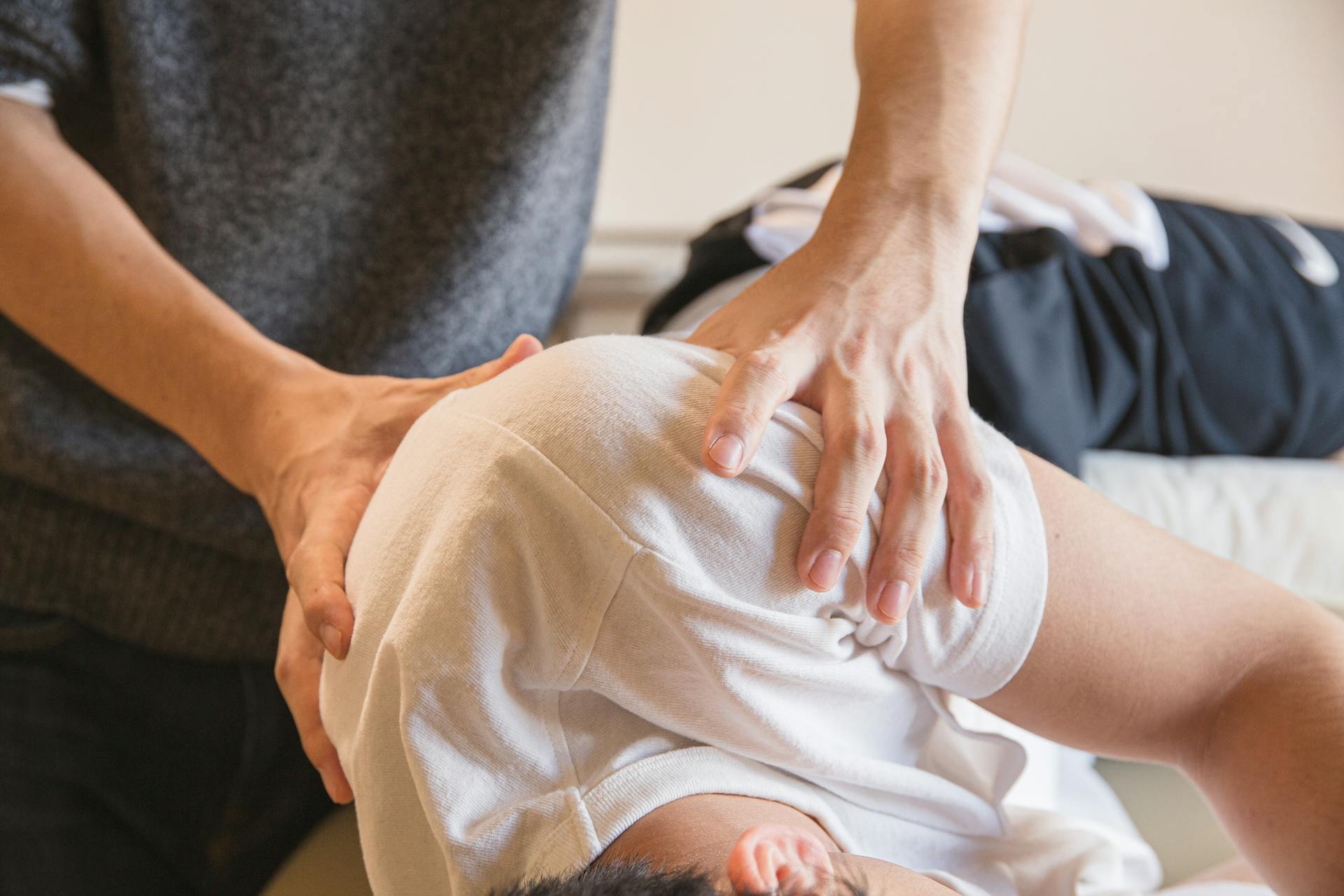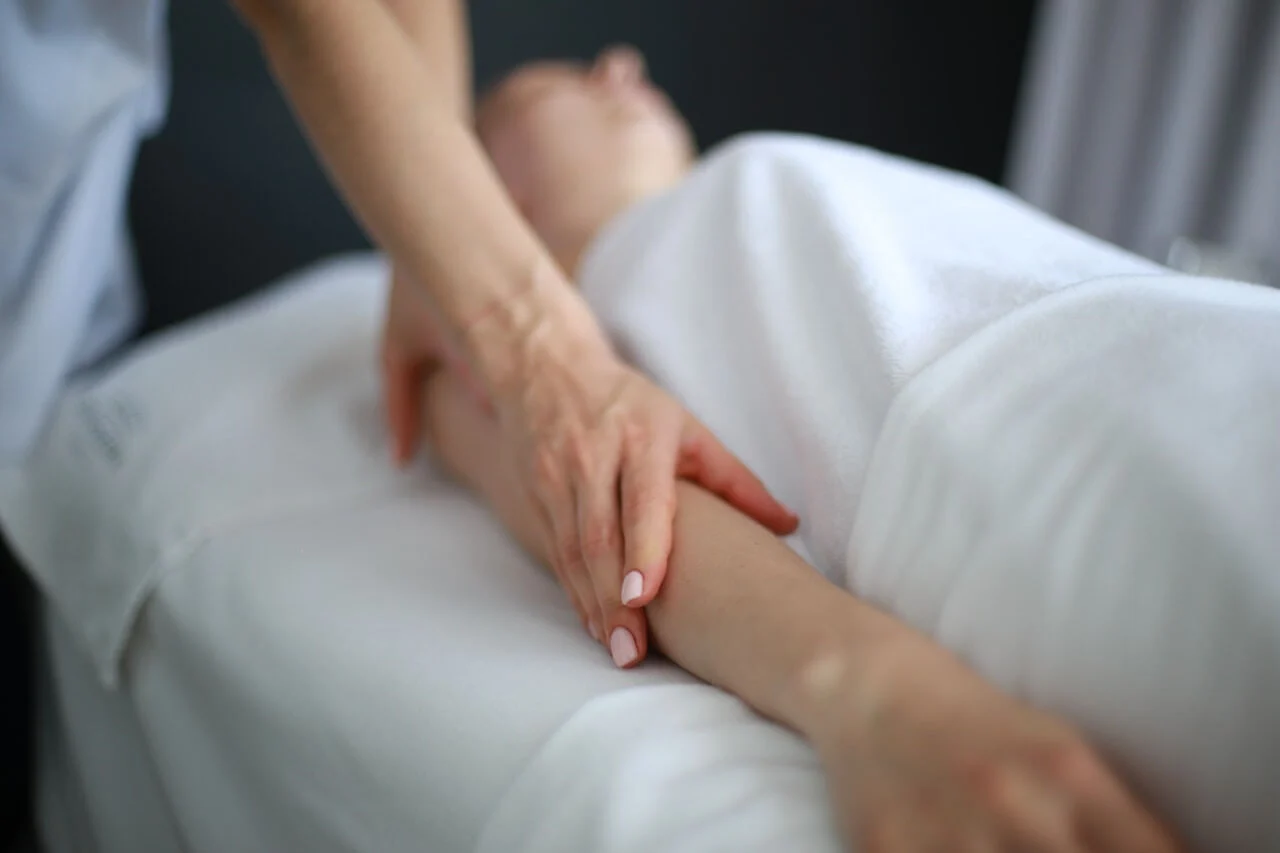There are 33 joints in your feet, which means a lot can go wrong when they don’t get the TLC they need. And when it comes to sources of foot pain, bunions are one of the most common culprits.
These bony growths occur on the outside of your big toe, causing it to point inward and radiate pain while you walk. And for some, the pain can persist all day long. But if you’re looking for home remedies to add to your treatment plan, could massage therapy be worth a try?
Below, we’ll dive into the details on bunion massage, including its potential benefits, four techniques to try, and other tips to keep in mind.
What Exactly Is a Bunion?
Bunions (also called hallux valgus) are bony bumps that form on the outside of the big toe joint. As they develop, they can lead to swelling, inflammation, stiffness, and pain in the area, especially when you walk. But for some people, these bony deformities can cause a chronic, achy sensation that persists even when not bearing weight.
Causes of Bunions
Experts believe that specific genetic structures of feet — like flat feet or other abnormal shapes — are one of the primary causes of bunions.
It’s also thought that overly-narrow shoes (which force you to contort your toes into a small space) can play a role in these painful growths. Using the wrong shoes won’t increase the risk for everyone, but it may be a problem for those with certain feet shapes.
To avoid this, watch out for designs that focus more on fashion than comfort. Some of the most popular examples of this include high heels, flats, and other tighter footwear.
The slender tips of shoes like these can put some serious strain on the feet bones — and interestingly enough, they may be one of the reasons why women are more likely to suffer from bunion pain than men.
Are Bunions Reversible?
Unfortunately, there aren’t any known ways to reverse a bunion once it forms. This is because a bunion is made of bone, and surgery is the only real way to “remove” it.
With that being said, there is some good news: If you catch your bunion early enough, the right treatments can help improve your toe alignment and keep your pain levels to a minimum.
Common Treatments
So, what kind of treatments are used to address bunion pain? Some of the most common options include:
- Changing your footwear. Shoes with wide toe boxes, orthotic inserts, and toe spacers are some of the most popular remedies for managing bunion pain.
- Pain relievers: If the pain is interrupting your daily life, your doctor may recommend trying over-the-counter pain relievers.
- Cold packs: Icing your feet can bring some relief when the inflammation or pain flares up.
- Physical therapy: Manual therapies, foot mobilization techniques, and specific exercises can all help support the structures in your feet.
- Surgery: If all else fails and your symptoms are progressing, your doctor may eventually recommend surgery. The procedure typically involves removing the growth and realigning your tendons, bones, and ligaments.
What Are the Benefits of Bunion Massage?

Massage is a go-to remedy for all types of foot discomfort — and for many, it can provide meaningful relief from bunion pain.
While massage can’t make a bunion go away, it’s important to note that it can help support mobility, relieve pain, and break up tension in the feet.
This is on top of the many other benefits that foot massage can offer — including supporting circulation, stimulating the muscles, and even curbing stress. And if you have other conditions affecting your feet — like plantar fasciitis or heel spurs — it may also help soothe the pain associated with them.
4 Bunion Massage Tips for At-Home Relief
With all these benefits in mind, here are four simple tips to help you try bunion massage at home:
1. Big Toe Mobility Massage
If your bunion is causing stiffness and lack of mobility in the big toe, this simple massage technique may help.
UK-based physiotherapist Daniel Lawrence explains how to do an in-depth version of this massage on his YouTube channel — but for the quick and easy version, here’s how you can try it for yourself:
- Sit in a comfortable chair, and cross your affected foot over your opposite knee. This will make it easier for you to reach your foot.
- Use both hands to gently press into the soft tissue on the top of your feet, between your big and middle toes. This area has tiny muscles that sit between the two long bones (known as your metatarsal bones).
- At the same time, use your thumbs to apply pressure on the bottom side of these muscles. With light pressure, massage this area for 1 to 2 minutes.
- Then, pull your big toe backward using one hand. With your opposite thumb, gently knead along the underside of your toe joint for 30 to 60 seconds.
- Spend a minute or two more gently pulling and rocking your toe joint back and forth to encourage mobility in the joint.
2. Try a Hands-On Arch Massage
If your big toe is especially tender to the touch, a hands-on arch massage can help you find some all-over relief. Not only can this technique ease foot discomfort, but it can also soothe the muscles around heel spurs or plantar fasciitis pain.
Here’s how to get started:
- Find a comfortable seat, and position your foot so that it’s easily in reach.
- With moderate pressure, use both thumbs to knead along the soft tissue of your foot’s arch. Start from near the heel and make your way up to the ball of the foot. Repeat for 1 to 2 minutes.
- Optionally, you can use your knuckles for deeper relief. Simply ball your hand into a fist and glide from the heel up toward the toes.
- Repeat these steps for a total of 5 to 10 minutes.
3. Myofascial Release with a Tennis Ball
To reap the benefits of self-myofascial release on your feet, try using gentle pressure with a tennis ball. This type of manual massage can help you target specific pain points, all while stretching and lengthening the muscles in your feet.
Simply:
- Place a tennis ball underneath the ball of your foot.
- Use light pressure to roll it forward and backward. Be slow and intentional as you roll, pausing and holding the pressure over any tight bands of tissue.
- Repeat for 5 to 10 minutes, up to a few times per day.
4. Try an Electric Massager

Electric massage tools offer one of the easiest ways to get an effortless, daily bunion massage at home.
While most foot massagers aren’t explicitly made for bunion pain, many people find that they can bring broad relief to tired and achy feet.
The MedMassager Foot Massager Plus is one FDA-certified option that uses oscillating motions for deep, restorative foot massage. Here are the basic steps to using this tool (or one like it):
- Begin by turning the massager to a low-intensity setting.
- Place your feet on the massage surface and allow it to warm up the muscles for 30 seconds or so.
- Increase the intensity to whatever level feels good to you. Allow your feet to soak up the massage for 10 to 15 minutes.
- Repeat a few times per day as needed.
Note: Every case of bunion pain is different. To stay safe, be sure to get the OK from your doctor before trying electric massage tools on your feet.
Can You Use a Massage Gun for Bunion Pain?
Massage guns are incredibly useful, versatile tools that provide quick and easy deep-pressure massage. But the bottom of the feet — especially when you have a condition like a bunion — can be extremely tender. So, if you use one of these devices, it’s important to do so with care.
When using one, remember to:
- Opt for a large, round, soft attachment, as this tends to work best on the delicate feet muscles.
- Start with light pressure, and aim the gun at an angle along the soft tissue on your feet. (Many people find it soothing to focus on the arch.)
- Only use it for 1 to 2 minutes on each foot.
- Avoid massaging directly over bone or irritated areas, as this may worsen pain and inflammation.
Bunion Massage Tips and Precautions
While bunion massage is a relatively safe remedy to try, the severity of your bunion (and any other conditions you may have) could affect the way it impacts you.
With that in mind, here are some safety tips to remember before getting started:
- Avoid massaging anywhere that is significantly painful or inflamed. Instead, focus on the surrounding soft tissue — and remember that while massage can cause mild discomfort in tight muscles, it should never be outright painful.
- Watch out for blisters, bruises, cuts, and broken skin while you massage the feet.
- Talk to your doctor if you have any medical conditions that foot massage may interact with.
Other Home Remedies
A good foot massage is a great option when you need some short-term relief from bunion pain. But there are plenty of other ways to tackle your symptoms — whether that means investing in new footwear or improving your toe mobility as a whole.
As you work to manage your bunion pain, here are some other remedies that your doctor may recommend:
Supportive Footwear
As we covered earlier, wearing shoes that are too narrow or have awkward, unnatural shapes can result in additional pain for those suffering from bunions. Fortunately, choosing the right shoes could make a world of difference in your day-to-day comfort.
So, what should you look for in a set of shoes? Try to find ones that:
- Have a wide space for your toes to fit. Shoes like flats, heels, and even narrow tennis shoes can “squeeze” your toes together and worsen the pain. On the other hand, choosing shoes with wider toe boxes will give your feet more room to rest in their natural alignment.
- Have soft cushioning and adequate arch support. Avoiding stiff and unsupportive shoes can also help your feet stay comfortable as you walk and move throughout the day.
Toe Spacers
Toe spacers are gel or silicone tools that can help take some pressure off of your feet. For many people, these convenient pads bring relief by adding extra cushioning and generally giving the toes a nice, long stretch.
Toe spacers don’t work for everyone, but depending on your level of pain and bunion severity, it may be worth asking your podiatrist whether they could be helpful for you.
Joint Mobility and Strengthening Exercises
Specific bunion exercises are another step you can take to help relieve pain and stiffness around the toes. In fact, the right exercises can build up the muscles around the joints and even lead to a modest boost in toe alignment, according to the Cleveland Clinic.
It’s important to note that your feet will need a healthy balance of rest and movement to maximize your recovery. So, it can help to add some exercises to your routine, but don’t forget about giving your feet time to recuperate.
Keeping that in mind, here are three bunion exercises to strengthen and support your toes:
Toe Circles
Toe circles are a simple exercise designed to reduce stiffness and increase mobility around the big toe joint. Here’s how to try them:
- Sit in a comfortable chair, and rest your affected foot over your opposite knee.
- Gently grab hold of your big toe and move it in a clockwise circular motion for 10 to 20 reps.
- Repeat in the opposite direction for another 10 to 20 reps.
- Repeat for 1 to 3 sets on each foot.
Marble Pick-ups
Marble pick-ups are a conditioning exercise that can help promote strength and flexibility in all of your toes — and a bonus is that they can also boost your overall foot stability.
To try this movement, you’ll need a set of marbles and a bowl to place them in. From there, simply follow these steps:
- Sit or stand and place the marbles on the ground in front of you.
- Use your toes to pick the marbles up, one by one, and place them in the bowl.
- Pick up 20 marbles with one foot, and repeat with the other side.
Toe-Spread-Outs
This easy stretch can help break up stiffness in your toes, all while engaging many different muscles in the bottom of the feet. To do them:
- Sit with your heels planted on the floor.
- Lift and spread your toes, and hold for 2 to 3 seconds. As you hold your toes up, be sure to keep your heels firmly on the ground.
- Repeat for 2 to 3 sets of 20 reps.
When to Talk to Your Doctor
With mild bunions, simply sticking to the correct footwear, using custom orthotics, and doing special exercises can often help your pain stay manageable.
However, every person’s situation is unique, and your path to relief may look different than someone else’s.
With that in mind, it’s essential to schedule a visit with a podiatrist if you notice new bunion pain or a visible bump near your big toe. Beyond that, talk to your doctor if:
- Your pain is worsening or not improving after trying home remedies
- Your pain is ongoing, persistent, or getting in the way of your daily activities
- You’re having trouble finding shoes that fit comfortably
- You have diabetes, as feet health problems are often more complicated with this condition
The Takeaway
Bunions can cause some serious discomfort when you walk, run, and move throughout your day. Thankfully, a good foot massage can work to soothe your achy feet — and when paired with your doctor’s recommended treatment plan, it can make a big difference in your overall relief.
If you haven’t yet, be sure to have a conversation with your doctor about which treatments are right for you. For mild bunions, you’ll often be able to keep symptoms at bay with proper shoes and a solid foot health routine. But if you end up needing more comprehensive help, a podiatrist is the best person to guide you through the journey.
Therapeutic Foot Massage at Home
Looking for deep, therapeutic foot massage in the comfort of your home? The MedMassager Foot Massager Plus is one physician-trusted device that can help.
Pick it up here or learn more about its many soothing benefits today.



